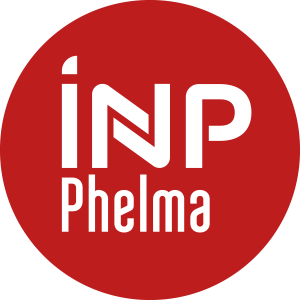Number of hours
- Lectures 2.0
- Projects 0
- Tutorials 18.0
- Internship 0
- Laboratory works 0
ECTS
ECTS 2.0
Goal(s)
- Study the thermodynamics of liquid and solid mixtures and the chemical reactions involving these mixtures. Applications to practical cases.
- Describe the structure and morphology of surfaces and interfaces.
- Understand the basic concepts that govern the mechanical and physico-chemical equilibra of the systems involving interfaces. Application to wettability and adhesion.
- Present some aspects of the joint involvement of thermodynamics and physico-chemistry of surfaces and interfaces in the study of small systems. Application to homogeneous and heterogeneous germination.
Content(s)
Introduction: The physicochemistry at Phelma
1. Mixtures and chemical reactions:
Solid and liquid solutions.
Reminders on the molar and partial molar thermodynamic quantities of mixtures, application to binary mixtures.
Activity in mixtures, reference state.
Solution models - description in pair interaction. Ideal, regular, diluted solutions.
Thermodynamics of chemical reactions involving liquid and/or solid solutions. Applications to some cases of practical interest.
2. Generalities on surfaces, interfaces and interphases:
Introduction
The surface and its defects.
Adsorption.
Evaluation of the energy of a solid/vapor surface.
Interfaces, interphases.
3. Mechanical and physico-chemical equilibrium of systems comprising interfaces:
Equivalence between surface tension and surface energy of a liquid.
Mechanical equilibrium of a heterogeneous system.
Evolution of a system comprising plane interfaces. Equilibrium shape of a crystal.
Interfacial energy and segregation in binary systems.
4. Wettability and adhesion:
Fundamental of wetting equations.
Adhesion work.
Applications: Capillary rise. Shape of drops (capillary forces versus gravitational forces).
Wetting of real surfaces: effect of roughness and heterogeneity
5. Thermodynamics of small systems (involving interfaces):
Gibbs-Thomson relation and applications: Modification of saturation vapor pressure and melting temperature of a pure substance. Increase in solubility of a small crystal of a pure substance in a liquid solution.
Thermodynamics associated with nucleation: Homogeneous nucleation. Heterogeneous nucleation. Applications.
Prerequisites
Concepts and tools of basic thermodynamics
- In presence
Session 1:
Continuous control (10%) + Written exam, 2h, the only permitted document: 1 page A4 double-sided handwritten, calculator allowed (90%)
Session 2:
Continuous control (10%) + Written exam, 2h, the only permitted document: 1 page A4 double-sided handwritten, calculator allowed (90%)
- In distance:
Session 1:
Continuous control (10%) + Written exam, 2h, all documents and calculator allowed, monitored by zoom (90%)
Session 2:
Continuous control (10%) + Written exam, 2h, all documents and calculator allowed, monitored by zoom (90%)
Session 1: Contrôle continu (10%) + Examen écrit (90%)
Session 2: Contrôle continu (10%) + Examen écrit (90%)
D.R. Gaskell. Introduction to the thermodynamic of materials. 4th edition, Taylors Francis, 2003
P. Desré, F. Hodaj, Thermodynamique des matériaux - équilibres de phases et métastabilité. EDP Sciences, 2010
C.H.P. Luis, Chemical thermodynamics of materials. Elsevier, 1983
P. Papon, J. Leblond. Thermodynamique des états de la matière. Hermannn, 1990
P.G. de Gennes, F. Brochard-Wyart, D. Quéré, Gouttes, perles et ondes. Belin, 2005.



